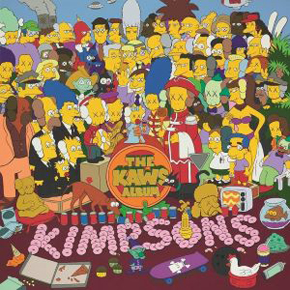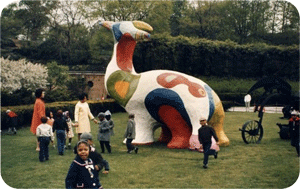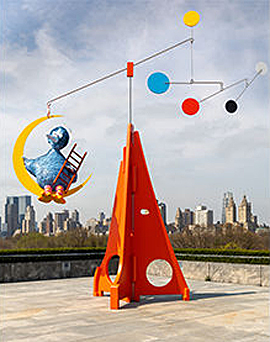Childish or Gifted?
John Haberin New York City
KAWS (Brian Donnelly), Niki de Saint Phalle, and Alex Da Corte
For once, you would be crazy to skip the museum gift shop—after a career survey of Brian Donnelly, or KAWS to fans and friends. The only question is whether to skip the rest of a charming but utterly vacuous show at the Brooklyn Museum. Unless, that is, the real question is what has happened to the art market and museums.
If that seems more than childish enough, Niki de Saint Phalle may have been the most child-friendly artist ever. She filled parks and playgrounds with the shapes of real and fantastic animals. Rather than a museum sculpture garden, she preferred Central Park's Conservatory Garden, where she installed her sculpture and handed out balloons to the kids.  When she set to work on the fight against AIDS, her posters speak of boyfriends and condoms, but the illustrations look awfully innocent for those in need of either one. She called a long-running series in fiberglass her Nanas, or girls, while Alex Da Corte visits the Met's rooftop bar, where the pandemic and the art leave no room for grown-ups or a drink. Just how suitable, though, are they for children?
When she set to work on the fight against AIDS, her posters speak of boyfriends and condoms, but the illustrations look awfully innocent for those in need of either one. She called a long-running series in fiberglass her Nanas, or girls, while Alex Da Corte visits the Met's rooftop bar, where the pandemic and the art leave no room for grown-ups or a drink. Just how suitable, though, are they for children?
Saint Phalle's MoMA PS1 retrospective is an enormous lost opportunity, especially given the enormous clout of the Museum of Modern Art. The architect of parks and playgrounds dared you to come out to play. So why not recreate an installation in a New York park? One must see her instead through sculpture and documentation. Smart critics have raved, but could they rely just as much on vivid memories? You will have to trust to her gift for pandering to while provoking you.
Brand new
Born in 1974, Brian Donnelly did not fashion himself an artist right away, but it took him no time to see the sales potential. He has turned out increasingly pricy t-shirts, tote bags, toys, and furniture. If his art looks like little more than cuddly cartoons, he had only to pile up the stuffed creatures to create a sofa, waiting for you to join the happy, hapless crowd. He was merchandising himself all along, from his very start as a street artist. What is tagging, after all, but branding? Never mind that, so late in the game, his brand was hardly original.
To be sure, one could consider oneself up on KAWS from the museum lobby alone. It has two of his cartoon Companions, an enormous loving couple in polished wood. He has been turning more and more to that line of goods to distinguish himself as a proper artist, with temporary installations in Asia. After anime, Japan and its neighbors know cartoons as art as nowhere else. Where he could not trouble to build them up or to take them down, he can always Photoshop them into the picture. Count on a good marketer to rebrand old tricks as "augmented reality."
The Brooklyn Museum spares no pains to dignify the brand, with the KAWS collectioncoming soon to the Drawing Center. Do those larger than life companions call in question what it means to be human? Not really, no more than his tags were "bold gestures," but a touch of existential anxiety sounds only proper in a serious museum. So does the thought that Donnelly chose his tag for the "graphic potential of its four letters." For those less concerned for esthetics, he just liked how they look—or maybe just be-KAWS. Ever after, he has sought the twin pleasures of creature comforts and flinging them in your face.
Skipping the show would miss out on both, and it will not, I promise, eat up an afternoon. How could it, when you recognize instantly Elmo and SpongeBob SquarePants? It is not as if KAWS were hiding his sources, other than to give them X's in place of eyes. True, the Simpsons (or rather Kimpsons) pose as Sgt. Pepper's Lonely Hearts Club Band, selling for $14.7 million at auction, but then no album cover has been so mocked and imitated—apart from the band's own Abbey Road. And charming they are, like a bright red and notably androgynous Michelin Man barreling through. Think of the X's more as further branding than effacement.
The real pandering, though, is the museum's, and it is not contemporary art's first or, I fear, the last. Saint Phalle created playground sculpture back in the Beatles era, Dewey Crumpler has used cartoons to further the American American cause in paint, and artists like Mike Kelley made their names as overgrown children. Paul McCarthy played one again this spring in Chelsea. Still, they staked their careers on adult sex and irony, and Jeff Koons comes with more fancy excuses than I can count. More and more, too, museums are happy to draw crowds with shows of pop-culture idols, like David Bowie out in Brooklyn itself—and it anticipates crowds this time, too, when it requires full rather than suggested admission. Every time I want to say that the bottom line has reached its intellectual bottom, someone is waiting to prove me wrong.
Donnelly's saving grace is to dispense with the excuses. His creatures with marks in place of facial features may not exactly smile, but I dare you not to raise a smile yourself, if only a weary one. And he does have a sense of "graphic potential," even as he invades the sphere of fine art. His bright colors translate to recent paintings close to abstraction, with brushwork that evokes Roy Lichtenstein and his Pop Art mirrors. Now if only you could sustain that smile after you go, as you reflect on collectors, museums, and his art.
Suitable for children
You might be hard pressed at MoMA PS1 to find work suitable for adults, but look again. Niki Saint Phalle started out with Tirs, or shootings, which had her taking a rifle to her art, releasing paint spatters as its blood.  Her retrospective, like her garden, centers on a huge sculpture with exaggerated "tits and ass," and the playground slide is the tongue of a dragon. Nanas means girls only as demeaning slang for attractive young women—and Emile Zola's fictional Nana grew up to become a whore. Her Golem for Jerusalem takes its name from a demon endowed with human life, and critics worried that it would teach aggression. She funded it all by merchandising at that, another unfortunate trend in contemporary art, with a line of perfume.
Her retrospective, like her garden, centers on a huge sculpture with exaggerated "tits and ass," and the playground slide is the tongue of a dragon. Nanas means girls only as demeaning slang for attractive young women—and Emile Zola's fictional Nana grew up to become a whore. Her Golem for Jerusalem takes its name from a demon endowed with human life, and critics worried that it would teach aggression. She funded it all by merchandising at that, another unfortunate trend in contemporary art, with a line of perfume.
A bemused headline spoke for the proper and pious: qui a autorizé cette "horror"? I wish I could take credit for having authorized the horror, but I was only a child myself, and anyway I worry more about the grownups in the room. I have the same feeling faced with such bad girls and bad boys in contemporary art as McCarthy, Koons, and Kelley. While MoMA PS1 has a soft spot for overcrowded shows, the two hundred works reflect an artist with little patience for restraint, and they come padded with no end of photos and studies. I breezed through in record time. She often collaborated with her second husband, Jean Tinguely, whose kinetic structure self-destructed for an eager audience at the Museum of Modern Art (or at least started to do so until the Fire Department showed up), and memories of her work may self-destruct even faster.
For all that, Saint Phalle combined the genuinely entertaining with a dark side worth remembering. She had her shootings, her dragons, and her work in the face of AIDS. She also had demons of her own. Born in 1930, the French girl grew up on the Upper East Side of New York, where she went to a privileged school and fell in love with Central Park. Yet she had her horrors, too, including child abuse. The artist who proclaimed that la mort n'existe pas (or death does not exist) spent her adult life in agony, from arthritis and worse.
No wonder she sought relief in the hopes of children. She also sought relief in the mystical, like a tarot deck of her own devising. "Order and chaos," she proclaimed, "are united in the eternal." Most of all, she sought relief in obsessive creation. She got the idea for her Tarot Garden after enjoying the excess of a cathedral by Antoni Gaudi in Barcelona, and its five acres found a home at last in Tuscany in 1998. And then she kept extending it, with a monumental figure here and a maze there, until her death in 2002.
The curators, Ruba Katrib with Josephine Graf, make no bones about the pain. They include a gilded altar to Jesus, snakes, bears, and bats. They argue, too, for Saint Phalle's place on the cutting edge. She collaborated with Jasper Johns, Robert Rauschenberg, Larry Rivers, and John Cage. Like Tinguely and Yves Klein, she joined France's Nouveau Realisme. If she departs from them all, she wished merely to make the mix more unruly.
There is no getting around the childish and the commercial in this Paradis Fantastique. The show comes just as KAWS, another merchandiser who harps on cartoons, has his run at the Brooklyn Museum. Still, we were all children once, and Saint Phalle's mysticism came wrapped up in her feminism. She wrote letters to Clarice, her favorite Nana, and one enters an installation through a female crotch in order, she reasoned, to return to the womb. She asked only, she said, that "you give me a few seconds of your eternity." Now if only that were enough.
Am I blue?
Could Big Bird outweigh Alexander Calder? Calder makes it look easy. To be sure, Alex Da Corte pays tribute to both on the roof of the Met. He emulates the delicate but stable equilibria of Calder mobiles, but also their form, with colored disks suspended from rods and wires—and one more disk sticking out on top. He emulates modernist simplicity as well in their black, white, red, yellow, and blue. Still, Big Bird weighs them all down.
As well he might, because he is, after all, big. He also rests on a crescent moon—or so I think, but it is the yellow of the sun. But then this Big Bird is bright blue, apart from a red, yellow, and purple tail. Here day becomes night and pleasure turns to melancholy, much as for his Sesame Street namesake, which is why you love him. Either way, he plainly wins out over fine art. The rods within the smaller mobile are strict horizontals, but the proverbial bird on a wire hangs lower in the sky. Not that it keeps him from looking up in distant longing, much as you must look overhead to see him. 
Da Corte at forty-one is an optimist, enough to call the work As Long as the Sun Lasts. He also pays tribute to his heritage, three times over. Born in New Jersey and based in Philly, he remembers a movie I somehow missed, in which the big yellow bird gets spattered with blue paint. He also remembers from childhood the Brazilian version of Big Bird, who really is blue, and modern American art. The mobile balances on what could pass for an Alexander Calder stabile, as a pyramid of three red planes pivoting on a central vertical. Each is a tall, slim triangle, but with holes picking up the disks and a gently curved hypotenuse picking up the moon.
If this is G-rated art, by all means bring the kids. Unlike last year, 2021 summer sculpture opens on time, but not yet for gathering over drinks. No IDs required. Is art after Covid-19 dumbed down for good, even on the Met roof? Probably not, but this season does have its share of overgrown children. Even so, Da Corte lacks the bad-boy antics of artists like Kelley—or the bad-girl edge of Saint Phalle taking a shotgun to art on her way to an oversexed playground. Some boys just want to have fun.
You could blame Calder himself. He has become not just the public face of modern sculpture, but a model for grade-school art as well. Still, even he had his Man-Eater, and this same summer MoMA puts him on the cutting edge of modern art. As for Da Corte, forget it. Even seven thousand aluminum feathers may not be all that great a burden in light of factories and assistants. As for art, our servants can do that for us.
The Met's roof was never just for children. Just right off, it certifies Da Corte as "serious" art, and I could instead have included him with more on 2021 New York summer sculpture. Nor is reaching out a bad thing, and education is a simply part of a museum's mission. Nor is art ostensibly for everyone, like that of Saint Phalle, without some serious adult challenges. Still, one had better start asking what she and others then have made possible today. Collectors in a hot art market may be spoiled children, too.

KAWS ran at the Brooklyn Museum through September 5, 2021, Paul McCarthy at Hauser & Wirth through April 10, Niki Saint Phalle at MoMA PS1 through September 6, and Alex Da Corte at The Metropolitan Museum of Art through October 31. A related review looks at KAWS as collector.




